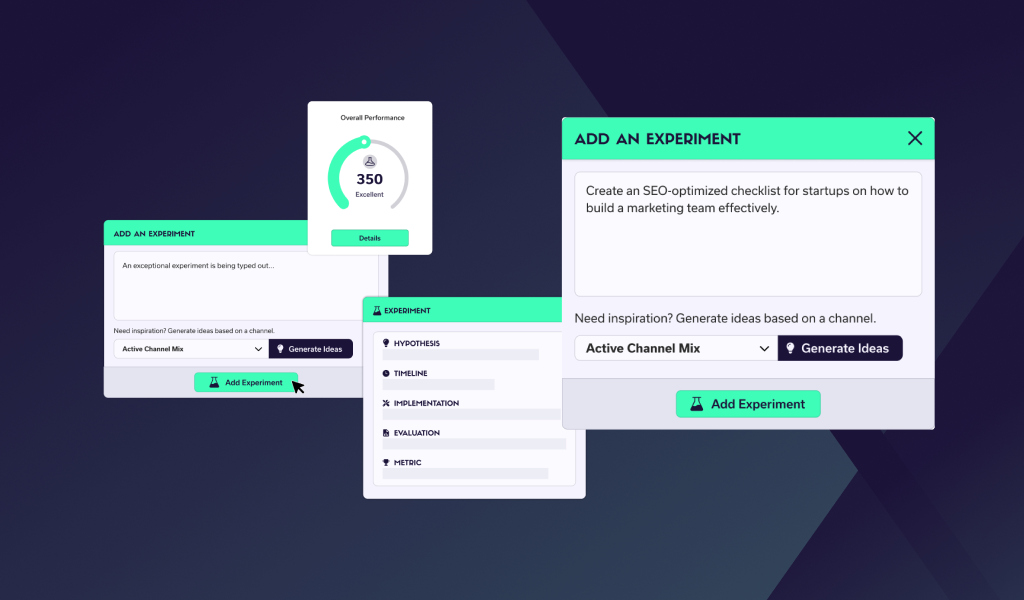In today's fast-paced digital landscape, businesses are continuously seeking new and innovative ways to accelerate their growth. Two terms that are often used interchangeably, but actually have different approaches and objectives, are growth hacking and growth marketing. In this article, we will delve into the basics of growth hacking and growth marketing, explore their key differences, discuss the pros and cons of each approach, and help you make the right choice for your business.
Understanding the Basics: Growth Hacking and Growth Marketing
Before we dive into the differences between growth hacking and growth marketing, let's define each term in more detail.
Growth hacking, a term coined by entrepreneur Sean Ellis, is a marketing technique that focuses on rapid experimentation and unconventional strategies to achieve fast and scalable growth for a business. It's a mindset that combines creativity and data-driven decision making to identify and exploit opportunities for growth. Growth hackers often leverage viral marketing, product optimisation, and other innovative tactics to achieve their objectives.
Now, let's turn our attention to growth marketing. Growth marketing, also known as growth-oriented marketing or growth-driven marketing, takes a more holistic approach to achieving sustainable growth. It involves utilising various marketing channels and strategies to drive customer acquisition, retention, and revenue growth. Growth marketers focus on understanding their target audience, optimising all stages of the customer journey, and implementing data-driven tactics to achieve long-term success.
While growth hacking and growth marketing share the common goal of driving business growth, they differ in their approaches and focus. Growth hacking is often associated with startups and early-stage companies that need rapid growth to gain traction in the market. On the other hand, growth marketing is more commonly practiced by established businesses looking to sustain and expand their customer base.
One of the key characteristics of growth hacking is its emphasis on experimentation. Growth hackers are constantly testing new ideas, strategies, and tactics to identify what works best for their business. They rely heavily on data analysis and feedback loops to iterate and optimise their marketing efforts. This iterative approach allows growth hackers to quickly adapt to changing market conditions and customer preferences.
In contrast, growth marketing takes a broader view of the customer journey. Growth marketers analyse the entire customer lifecycle, from initial awareness to post-purchase engagement, to identify opportunities for growth. They focus on building long-term relationships with customers and maximising their lifetime value. This involves implementing strategies such as personalised marketing, customer retention programs, and upselling/cross-selling initiatives.
Another distinction between growth hacking and growth marketing lies in their timeframes. Growth hacking is often associated with short-term, rapid growth objectives. Startups and early-stage companies use growth hacking techniques to gain traction and attract investors. In contrast, growth marketing takes a more long-term perspective, aiming for sustainable and scalable growth over time.
It's worth noting that growth hacking and growth marketing are not mutually exclusive. In fact, many companies combine elements of both approaches to create a comprehensive growth strategy. By leveraging the creativity and agility of growth hacking and the customer-centric mindset of growth marketing, businesses can maximise their growth potential.
In conclusion, growth hacking and growth marketing are two distinct but complementary approaches to achieving business growth. While growth hacking focuses on rapid experimentation and unconventional strategies, growth marketing takes a more holistic and long-term approach. By understanding the differences between these two approaches, businesses can develop a growth strategy that aligns with their goals and objectives.
The Key Differences Between Growth Hacking and Growth Marketing
While both growth hacking and growth marketing share the common goal of accelerating growth, there are several key differences that set them apart:
Approach and Strategy
Growth hacking is often characterised by its agility and willingness to take risks. It involves constant experimentation, testing, and iteration to find the most effective tactics for growth. Growth hackers tend to prioritise short-term gains and focus on creating viral loops and referral programmes to rapidly acquire users.
In contrast, growth marketing takes a more strategic and long-term approach. It emphasises building a strong brand, nurturing customer relationships, and implementing scalable marketing campaigns. Growth marketers aim to create sustainable growth by optimising every aspect of the customer journey and making data-driven decisions based on comprehensive analytics.
When it comes to growth hacking, it's like being a mad scientist in a lab, constantly tinkering with different formulas and concoctions to find the perfect recipe for success. It's about taking risks and thinking outside the box to find innovative ways to attract and retain customers. Growth hackers are the trailblasers of the marketing world, always on the lookout for the next big idea that will propel their company to new heights.
Growth marketing, on the other hand, is more like a well-oiled machine. It's about building a solid foundation and implementing strategies that will stand the test of time. Growth marketers are like architects, carefully constructing a marketing ecosystem that will support long-term growth. They focus on building strong relationships with customers, understanding their needs and desires, and delivering value at every touchpoint.
Timeframe and Results
Growth hacking is typically associated with quick wins and rapid growth within a short timeframe. It often involves leveraging viral marketing techniques and exploiting data-backed insights to achieve immediate results. The focus is on finding creative strategies that generate substantial growth in a short period.
Imagine a growth hacker as a sprinter, racing towards the finish line with lightning speed. They are constantly looking for shortcuts and quick wins to achieve explosive growth in the shortest amount of time possible. They thrive on the adrenaline rush of seeing immediate results and are constantly pushing the boundaries of what's possible.
Growth marketing, however, takes a more marathon-like approach. It's about playing the long game and building sustainable growth over time. Growth marketers understand that Rome wasn't built in a day and that true success comes from consistent effort and dedication. They focus on nurturing customer relationships, delivering value at every stage of the customer journey, and creating a loyal customer base that will generate revenue for years to come.
Growth marketing is like tending to a garden, carefully planting seeds and patiently nurturing them until they blossom into beautiful flowers. It's about cultivating long-lasting relationships with customers, understanding their needs and preferences, and adapting marketing strategies to meet their evolving demands.
Skills and Team Structure
Growth hacking requires individuals with a unique skill set, blending marketing, coding, and data analysis. Growth hackers are often self-starters who are comfortable with ambiguity and have a strong entrepreneurial mindset. They are skilled in viral marketing techniques, A/B testing, and analytics.
Growth hackers are the Swiss Army knives of the marketing world. They have a diverse skill set that allows them to wear many hats and tackle various challenges. They are the masters of coding, using their technical expertise to create innovative solutions and automate processes. They are also data wizards, using analytics to uncover insights and make data-driven decisions.
Growth marketing, on the other hand, takes a more interdisciplinary approach, involving expertise from various marketing disciplines. A growth marketing team typically consists of professionals with expertise in marketing strategy, branding, content marketing, SEO, social media, analytics, and more. Collaboration and a deep understanding of the customer journey are key to success in growth marketing.
Think of a growth marketing team as an orchestra, with each member playing a different instrument but working together to create a harmonious symphony. Each team member brings their unique expertise to the table, contributing to the overall success of the marketing strategy. They collaborate closely, sharing insights and ideas, and aligning their efforts to achieve the common goal of driving growth.
In conclusion, while growth hacking and growth marketing may share a common goal, they have distinct approaches, timeframes, and skill requirements. Growth hacking is all about agility, risk-taking, and quick wins, while growth marketing focuses on strategy, long-term sustainability, and collaboration. Both have their merits and can be effective in driving growth, depending on the specific needs and goals of a business.
The Pros and Cons of Growth Hacking
Growth hacking offers several advantages that make it appealing to many businesses, but it also comes with limitations:
AdvantagesDisadvantages1. Quick and scalable growth
2. Cost-effective strategies
3. Agile and adaptable approach
4. Highly measurable results1. Focuses primarily on short-term gains
2. Requires a high level of experimentation
3. May not be suitable for all business types
4. Can be risky and result in failures
The Pros and Cons of Growth Marketing
Growth marketing offers several advantages that make it a compelling approach for businesses, but it too comes with limitations::
AdvantagesDisadvantages1. Focus on long-term, sustainable growth
2. Comprehensive understanding
of the customer journey
3. Data-driven decision making
4. Consistent and predictable results1. Requires more resources and expertise
2. Results may take longer to materialise
3. Less room for quick experimentation
4, Can be more complex to implement
Choosing Between Growth Hacking and Growth Marketing
Deciding whether to adopt growth hacking or growth marketing depends on various factors:
Factors to Consider
- Business objectives and growth goals
- Available resources and budget
- Competitive landscape and industry
- Stage of business development
While growth hacking may be suitable for startups or companies looking for explosive growth in a short period, growth marketing is often better suited for businesses aiming for sustainable, long-term growth.
Making the Right Choice for Your Business
Ultimately, the choice between growth hacking and growth marketing depends on your unique business goals, available resources, and target audience. Both approaches have their merits, and there's no one-size-fits-all solution. Consider the pros and cons of each approach and align them with your business objectives to make an informed decision.
In conclusion, growth hacking and growth marketing are different approaches to achieving growth, each with its own strengths and weaknesses. Understanding these differences and evaluating your business's specific needs will help you choose the right path to drive sustainable growth and success.
Talk to a Growth Advisor
We create a clear, focused marketing strategy by combining our expertise with your knowledge of your business.
Trusted by over 130 startups because our unique growth process and team of marketing experts unlock exponential growth











